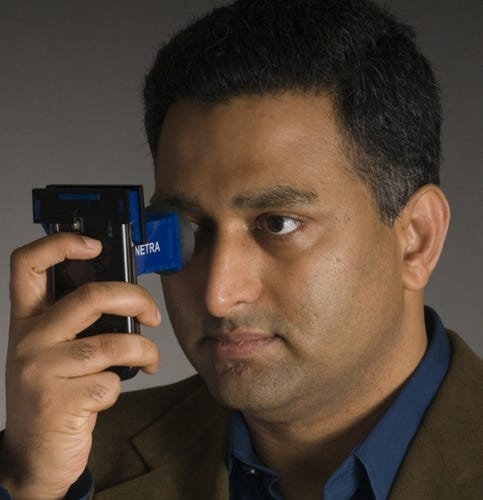April 10, 2013
A BIOMEDevice Boston keynote talk from MIT Media Lab's Ramesh Raskar, PhD was similar to a TED talk--entertaining as it is informative. The resemblance to that conference format is fitting, as Raskar has spoken at that venue before and will be speaking next week at TEDMED.
|
In his BIOMEDevice talk, Rakar said he would demonstrate at an upcoming cocktail party how the eyeNETRA technology could be used to test visual acuity. "How often can you be drinking a glass of wine and have your eyesight tested?" he asked. |
In his talk, he discussed the workings of a camera developed at MIT that can image at one trillion frames per second as well as its ability to see beyond the line of site. In addition, he touched on his work developing low-cost mobile phone attachments that also can detect cataracts. As Raskar explained, the breakthrough is significant as slit lamp technology for detecting cataracts hasn't changed substantially in 30 or 40 years. In addition, retinal scan technology has poor user interface, requiring that patients have their head uncomfortably positioned against them to operate.
"We took this up as a challenge and came up with eyeNETRA--a snap on eye piece for smart phones. When you are done testing, it calculates the prescription of your eyeglasses and the measurements are more accurate than more expensive refractors and subjective tests," he explained. "It can also scan for early stage cataracts as a bonus."
The device reflects a trend of a growing number of devices that harness the horsepower of smartphones for medical applications. The pixel pitch is about 30 or 40 micrometers on a smartphone. That resolution exceeds common clinical-grade optometry equipment.
Smartphone displays also have other advantages, as they offer connectivity and a range of functions not found in many medical devices. NETRA technology is the inverse of Shack-Hartmann wavefront sensor. A person using the device sees a number of spots and repeatedly clicks until a single dot is perceived. "The number of clicks indicates your prescription," he said.
Ramesh spun the technology into a startup to, as he put it, "bring glasses to the masses" in the third world. "Thanks to the efficient supply chain, distribution of glasses has become very easy. We can deliver them for $3 and it still make money."
In his talk, Raskar also discussed at length his lab's high-speed imaging technology, which will give clinicians powers resembling that of a superhero's, Raskar quipped. "Some superheroes can fly, a future superhero can see around corners." (MPMN wrote a piece explaining how the technology works.)
The technology could be a boon for medicine. "If you can see around corners, you can see deep inside the body - well beyond the reach of the tiniest endoscopes on the market today."
After Nature posted the following video explaining how the imaging technology worked to YouTube, Raskar's Camera Culture Group in the MIT Media Lab has been inundated by requests from medical device companies interested in using the technology in applications such as endoscopy, Raskar said. The technology also could be used for other applications as well--building cars that can see around corners to avoid collisions or by rescue operations seeking to look for survivors in burning buildings.
The question most people have though is why we used a Coke bottle to demonstrate how the technology can capture light travelling in slow motion. Raskar provides an answer: "you know how it is in the lab, you look around to see what is available and there are usually lots of Coke bottles."
Brian Buntz is the editor-in-chief of MPMN. Follow him on Twitter at @brian_buntz.
About the Author(s)
You May Also Like



